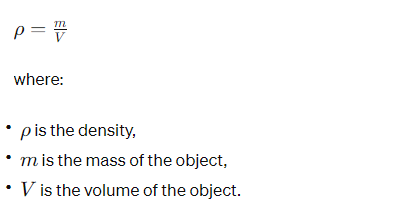Calculating density involves dividing an object’s mass by its volume. The formula for density (‘ρ) is:
‘=”ρ=Vm
where:
- ‘ρ is the density,
- ‘m is the mass of the object,
- ‘V is the volume of the object.
Here’s an example of how to calculate the density of a block of aluminum.
First, use a scale to measure the mass of the aluminum block. Suppose the block has a mass of 270 grams.
Next, measure the block’s volume. This can be done by measuring its dimensions and calculating the volume for regular shapes (like a rectangular block: length ×× width ×× height) or by measuring the volume of water displaced by irregular shapes. Let’s say the block measures 10 cm ×× 5 cm ×× 3 cm, giving a volume of 150 cubic centimeters.
Now, use the density formula:
‘=”ρ=Vm
‘=270 g150 cm3ρ=150 cm3270 g
‘=1.8 g/cm3ρ=1.8 g/cm3
Therefore, the density of the aluminum block is 1.8 grams per cubic centimeter.
